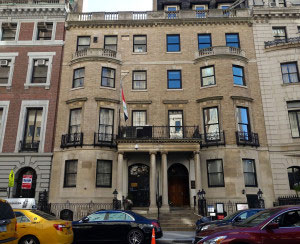
By Jamie Schram
The Mission of Iraq, which sits on a wealthy Upper East Side block near Central Park, has a dark secret: Its basement was used as a jail equipped for torture under Saddam Hussein’s regime, The Post has learned.
The Mission of Iraq, which sits on a wealthy Upper East Side block near Central Park, has a dark secret: Its basement was used as a jail equipped for torture under Saddam Hussein’s regime, The Post has learned.
When he rose to power in 1979, the despot had the terrifying “detention room” installed inside the five-story building at 14 E. 79th St. — right across from billionaire former Mayor Michael Bloomberg’s home, according to two Iraqi officials speaking on the condition of anonymity.

Saddam’s henchmen — known as Mukhabarat agents — frequently imprisoned local Iraqis in the basement for up to 15 days at a time, using them as leverage to get their relatives back in the homeland to surrender and cooperate with the tyrannical government, the officials said.
“It was a dark room. The doors were reinforced in a way that nobody could break in or out. You didn’t need to soundproof it,” one official said. The other official added, “You’re not going to hear someone screaming down there.”
The prison chamber was similar to detention rooms in Iraqi embassies around the world, including Eastern Europe and Arab countries, where evidence of torturewas uncovered, the officials said.

Some of the Gestapo-like tactics employed by the Mukhabarat involved the use of copper wire, rubber hoses and wooden planks. They would also pull out prisoners’ nails and beat them to a pulp, one official said.
Modal Trigger
In many cases, the Mukhabarat would kill Iraqis and ship them back to Baghdad in Customs-exempt packages.
“They just put [the body] in a diplomatic box and it can just be shipped. This is diplomatic — nobody has the authority to examine it or open it,” one official said, confirming that Saddam’s secret police had committed such atrocities in countries outside the US.
“Mukhabarat does whatever the hell Mukhabarat needs to do. They are the last people you ever wanted to meet during the Saddam era,” one official said, referring to acts of violence.

But all evidence of such maltreatment was hauled away, the officials believe, when federal investigators stormed the mission after Saddam’s dramatic fall in 2003 during the American invasion of Iraq.
“US government officials came in. They took hard drives, computers. They went into vaults — they smash them open. Officially, they were running Iraq because we didn’t have a government. We got the mission back in less than a year,” the second official explained, pointing out that the Mukhabarat was sent home for good.
Almost four decades earlier, Saddam had turned the Mukhabarat from a national security agency into a group of savage spies.
He sent several of his most trusted spooks to the mission, where they set up shop in three main rooms in the basement. They each carried a 9mm semi-automatic pistol and they had access to several Kalashnikov rifles on the premise, the officials said.
The first room acted as their office; the second was a communications center, where they used an encryption system to send messages back and forth to Baghdad; and the third was the detention facility that was secured by a giant metal door with heavy steel bars across it.
To keep their operation strictly covert, the Mukhabarat blacked out a skylight in the roof of the five-story townhouse so the US Air Force and satellites couldn’t peer in. They also kept a watchful eye on American spies conducting wiretap surveillance from a car across the street, the officials said.

Saddam’s cabinet used dossiers they kept on all of their citizens to root out suspected enemies of his regime, contacting the Mukhabarat in New York to do some of his dirty work.
“Mukhabarat wouldn’t bring the relative of the target to the mission. They would lay in wait like a snake for the relative to arrive for some ex-pat business and then grab him and lock him into the room,” one official said.
The agents then called the man’s family to inform them that they would detain him until the “target” surrendered to the government in Iraq, said the official.
“Saddam said once, ‘If my own finger betrayed me, then I would have it removed or cut off,’” the official recalled.
But those days are long gone and so is Saddam, who was executed in 2006 after he received a death sentence for crimes against humanity.
In 2014, the hellish subterranean space was converted into a kitchenette during a full renovation of the mission that cost approximately $120,000.
In one of the grand rooms, framed portraits of past Iraqi leaders proudly hang on a wall, but Saddam’s face is noticeably missing.
“We had Saddam’s portrait painted on all the porcelain of each toilet,” one official joked.
The Iraqi mission declined to comment.
 khalijefars News, Blogs, Art and Community
khalijefars News, Blogs, Art and Community








